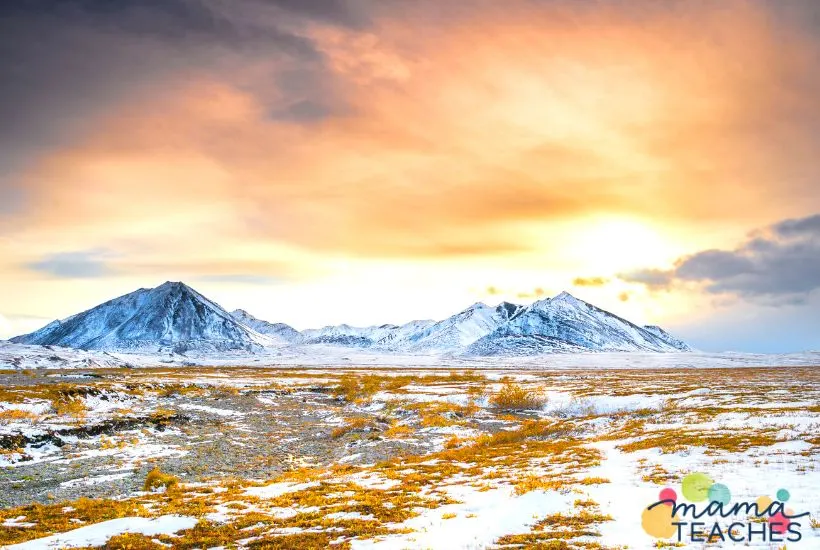Would you like to learn more about the Earth’s coolest biome? Read on for some fun facts about tundras!

Basic Facts About Tundras
The tundra is a land biome with frigid temperatures.
The soil is permanently frozen (this is called permafrost).
It has long winters and very brief growing seasons.
You can find the tundra near the poles of the Earth.
In the Northern Hemisphere, it is in the extreme north of Canada and Russia (north of the taiga biome).
In the Southern Hemisphere, the tundra is on the Antarctic peninsula.
Now that you know some basic facts about the tundra biome, let’s move on to some interesting facts about tundras.

This article contains affiliate links to things that you might like.
Fun Facts About Tundras
Read on for some fun facts about the tundra biome.
There Are No Trees in the Tundra
The tundra is frigid. It is so cold that the soil is permanently frozen.
No root system could pierce the frozen ground of the tundra. A tree cannot grow.
You can tell where the taiga biome ends and the tundra begins because the trees abruptly stop growing.
The taiga is the snow forest; the tundra is the colder, more barren biome.
The World Is Dotted with Tundras
There are two types of tundras: the Arctic tundra and the Alpine tundra.
The Arctic tundra is the land closest to the poles in the Northern and Southern Hemispheres.
The Alpine tundra is located on high-altitude mountains, where the weather is freezing and trees do not grow.
The Earth is dotted with Alpine tundra regions. For example, you can find them in the Alps, Pyrenees, and the Himalayas.
You can even find the Alpine tundra in the northern Appalachian Mountains and the high-topped mountains on the west coast of North America.
It is clear where the Alpine tundra begins on a mountain, just past the last line of trees.
The Alpine tundra differs from the Arctic tundra because the soil is well-drained.
Also, the Alpine tundra can sometimes support small shrubs or the occasional dwarf tree.

The Arctic Tundra Has Lots of Summer Lakes
The tundra is like a desert; there is little precipitation (rain or snow).
On average, it rains less than 10 inches a year.
Most of that rain happens in the summer.
Why do lakes form?
The soil of the Arctic tundra is permanently frozen, so the water cannot sink into the ground.
It floats on the top of the ground, forming vast, shallow lakes and marshes.
Arctic Plants Have a Thin, Shallow Layer of Soil in Which to Grow
Only the topmost layer of soil thaws in the summer, so plants with deep roots could not grow.
The Arctic tundra plants must have thin, shallow roots that can sling to the uppermost layer of soil.
These include lichens that cling to rocks or spread out in mats along the ground.
The Arctic does have summer flowers, like the purple saxifrage or the yellow Arctic poppy.
Most Arctic plants are very short; often, they are only a few centimeters tall.

In the Arctic, Caribou Munch on the Tongue Plant
The Arctic willow is a small, low-growing shrub with oddly shaped leaves.
The Inuit people thought the shiny, oval-shaped leaves looked like tongues, so they called the plant the “tongue plant.”
The Arctic willow is food for caribou, musk oxen, and Arctic hares.
The Inuit people use the twigs from the Arctic willow as kindling for fire.
They use the dried flowers as wicks in their oil lamps.
They also use the plant as an herbal medicine to relieve toothaches and stop the bleeding of wounds.
The Most Famous Resident of the Tundra Is the Polar Bear
The most notorious animal of the tundra is the polar bear.
They have thick fur and a layer of fat underneath their skin to keep them warm in the tundra’s freezing temperatures.
The hair of a polar bear is not white but transparent. The hair’s core reflects light like a mirror, making its fur appear white in the sunshine.
It would look blue under blue light, pink under pink light, etc.
Under their fur, a polar bear’s skin is black!
Polar bears are carnivores and mainly eat seals, but they will gobble up whatever meal they can get their paws on!

Oxygen Is in Short Supply in the Tundra
The tundra biome has less oxygen in the air than the nearby taiga.
That is because the taiga is a forest; the trees produce oxygen.
The tundra is a barren land most of the year and does not have oxygen-producing plants.
This does not mean the air runs out of oxygen; it just has a reduced amount compared to other biomes.
The Tundra Nights Can Last All Day
Because of the tilt of the Earth on its axis, the land of the Arctic is tilted away from the Sun during the winter.
Near the North Pole, it is entirely dark between November 13 and January 29.
Musk oxen and reindeer are specially adapted to survive this “polar night.”
Musk oxen have an incredible sense of smell. They can sniff to find plants buried underneath the snow.
Reindeer have eyes that can see ultraviolet light (unlike humans, who cannot see this light).
They can spot plants even during polar night’s darkness.
Polar bears use their incredible sense of smell to locate their favorite meal: seals.
Most tundra animals dig burrows and hibernate through the winter.
Other animals migrate to avoid this utterly dark season.

Interesting Facts About the Tundra Biome
The tundra is a harsh biome, yet certain animals and plants can survive and thrive there.
Get to know the tundra by reading these fun facts about tundras.
